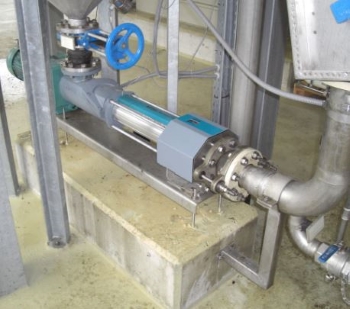
An existing pump, which conveyed thick sludge to an intermediate tank, showed a high level of wear due to the abrasive medium. The wastewater treatment plant therefore decided to replace it with a unit that is more robust and easier to maintain. A Nemo progressing cavity pump with a special “Full Service in Place” (FSIP) concept from German-based company Netzsch Pumpen & Systeme has therefore been used since 2016. This makes work on the pump equipment possible without dismantling it from the pipes. Overall, the new design saves time during inspection, repair and cleaning work while also reducing the required installation space. The xLC unit is an additional component available for Nemo pumps. When wear occurs in the rotor-stator system, this new technology allows the performance of the pump to be re-established several times before the stator finally needs to be changed by re-adjusting the preload in the rotor-stator system.
Until the change of the pump, the thick sludge generated after the centrifuge was conveyed to the sludge disintegration in an intermediate storage tank by a conventional progressing cavity pump with a pressure of up to 7 bar. “Because the solids ratio is over 8 percent, this unit was subject to a particularly high level of wear,” the water treatment manager at the plant explains. “The special texture of the medium was probably also a factor in this: It contains iron and aluminium salts from the tertiary sludge and also iron from the local industrial plant.” The pump therefore had to be serviced approx. every 8,000 operating hours.
Pump interior freely accessible with just a few moves
For the new acquisition, it was particularly important to the customer that the pump would have a significantly higher reliability and longer service life and would be especially easy to service. The customer finally selected the service-friendly FSIP version of the Nemo progressing cavity pump from Netzsch. Its design features a special inspection cover, among other things. This maintenance opening is cleverly positioned at the transition from the pump housing to the stator, allowing ideal access to the clamping coupling by removing the cover: “The cover is secured with just five screws that can be removed without any special tools in a really short time,” Mikael Tekneyan, development engineer at Netzsch, explains. “At the same time, we ensured that the pump will seal reliably at high pressures and with vertical installation of the pump.”
“Once the cover is open, only one screw has to be released in order to separate the rotor-stator element from the coupling rod,” Mikael Tekneyan explains. “Then the rotating unit can simply be lifted out with the rotor-stator element. This provides free access to the pump interior from flange to flange. “All wearing parts of the progressing cavity pump can be replaced without having to remove the pump from the pipes. Because all parts are removed sideways or upwards, no additional space is needed for removal. The dismantling length at the end of the pump, which had previously been essential, is no longer required, considerably reducing the required installation space. Source: Netzsch via Impeller.net |
